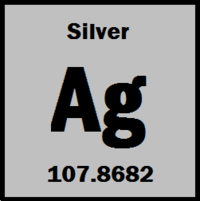Silver
Silver is the 47th element on the periodic table. Silver's chemical symbol "Ag" is derived from the Latin word for silver, argentum.[2] It is a soft, shiny metal, which tarnishes in air as sulfur compounds react with it.[3]
Some useful properties of silver include:[2][4]
| Atomic weight | 107.8682 |
| Density (at 0oC) | 10.501 g/cm3 |
| Boiling point | 2435 K |
| Melting point | 1234.93 K |
| Embodied energy | 1500 MJ/kg |
| Electrical conductivity | 6.3x107 m/ohm |
Silver is attained from the earth in silver mines, or as a byproduct from lead and zinc mines. Smelting and refining removes silver from the ore, which then must be purified for efficient use. Electronics for example demand highly pure silver - 99.99% pure.[5]
The average primary energy required to produce silver - known as its embodied energy - is relatively high compared to other metals, at 1500 MJ/kg.[6]
Uses of silver
Silver has the highest electrical conductivity of all metals, with copper having the second highest. This makes silver very useful in electronics, often being used for solder, electrical contacts, and printed circuit boards.[2] This conductivity also makes it an excellent reflector of light - hence being the origin of the name "silvered mirrors".
Silver is also of use in attaining solar power. It is first manufactured into what is called "silver paste", and is then applied to solar panels. The paste conducts the electric current produced by light hitting the photovoltaic cells, which allows electricity to flow elsewhere.[5]
An alloy of silver known as Sterling silver, made up of 92.5% silver, is used to make silverware, jewelry and other goods.
Silver bromide and silver iodide were used in the early stages of photography due to their high sensitivity to light, and some silver salts are still used in photo development, in order to produce high quality images.[3]
For other various uses of silver, see here.
Video
The video below is from the University of Nottingham's periodic videos project.[7] They have created a complete suite of short videos on every element on the periodic table of elements.
References
- ↑ Made internally be a member of the Energy Education team, with information from Jefferson Labs, Available: http://education.jlab.org/itselemental/ele047.html
- ↑ 2.0 2.1 2.2 Jefferson Labs. (Accessed May 16, 2016). The Element Silver [Online], Available: http://education.jlab.org/itselemental/ele047.html
- ↑ 3.0 3.1 Royal Society of Chemistry. (Accessed May 16, 2016). Silver [Online], Available: http://www.rsc.org/periodic-table/element/47/silver
- ↑ About. (Accessed May 16, 2016). Table of Electricity Resistivity and Conductivity [Online], Available: http://chemistry.about.com/od/moleculescompounds/a/Table-Of-Electrical-Resistivity-And-Conductivity.htm
- ↑ 5.0 5.1 Geology.com. (Accessed May 23, 2016). The Many Uses of Silver [Online], Available: http://geology.com/articles/uses-of-silver/
- ↑ UNEP. (August 19, 2015). Environmental Risks and Challenges of Anthropogenic Metals Flows and Cycles [Online]. Available: https://d396qusza40orc.cloudfront.net/metals/3_Environmental_Challenges_Metals-Full%20Report_36dpi_130923.pdf#96
- ↑ See more videos from the University of Nottingham on different elements here: http://www.periodicvideos.com/


